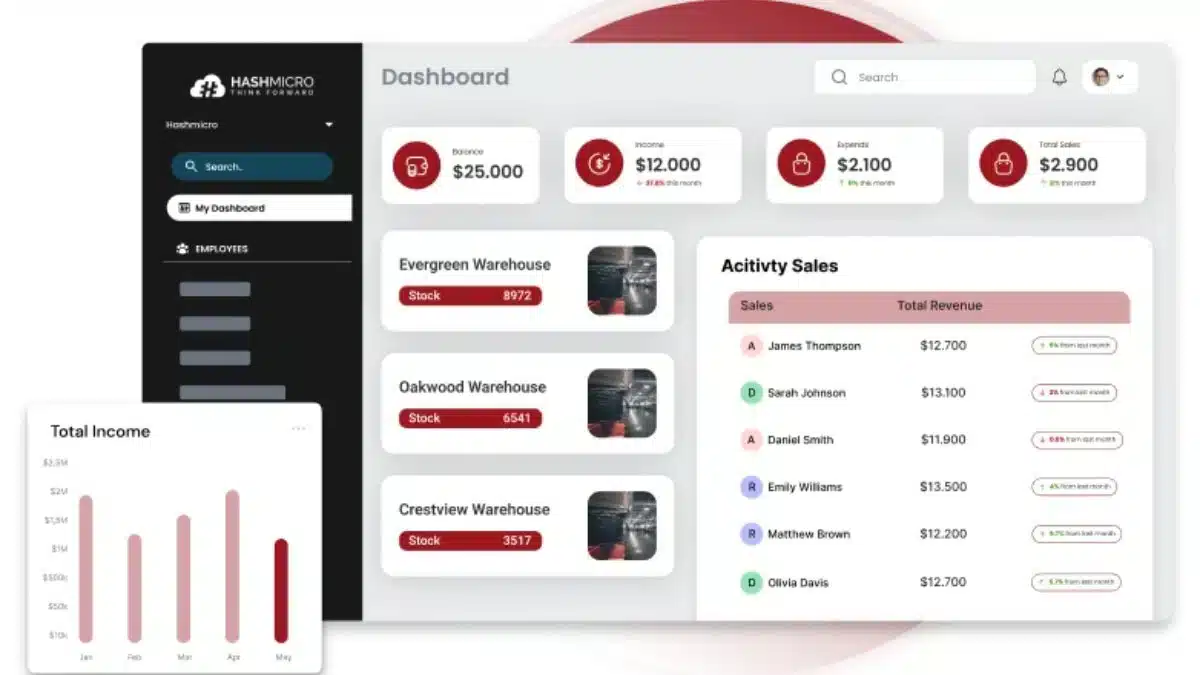In my experience, managing a modern warehouse often involves battling inventory inaccuracies and slow order processing. These common challenges can directly hinder growth if we don’t adopt the right technology, like a warehouse app.
These operational issues lead to decreased customer satisfaction and lost revenue, making a change necessary. Implementing a modern warehouse app is the solution to streamline workflows and regain control over our logistics.
This guide will explore how this technology can transform your operations for peak efficiency. Read on to discover the key benefits, essential features, and implementation strategies for 2025.

Key Takeaways
|
What Is a Warehouse App and Why Is It Crucial for Your Business?
A warehouse app is a software application designed for mobile devices to digitize and manage warehouse operations. It connects floor staff to the central management system for real-time task execution and data tracking.
This tool is crucial because it enhances data accuracy, accelerates workflows, and provides complete visibility over inventory. Automating manual processes empowers businesses to operate more efficiently and competitively.
Key Benefits of Implementing Warehouse App
Implementing a warehouse app introduces a suite of benefits that directly enhance operational efficiency and accuracy. It transforms manual workflows into a streamlined, digital process for greater control and productivity.
1. Drastically improve inventory accuracy
A warehouse app minimizes stock discrepancies by using barcode scanning for real-time inventory updates. For instance, every item received or shipped is scanned, ensuring system data always matches physical stock.
2. Accelerate the order fulfillment process
This technology speeds up order fulfillment by providing optimized picking routes and digital task lists. Staff can locate and verify items faster, reducing the time from order placement to customer delivery.
3. Optimize labor productivity and efficiency
The app empowers your workforce by replacing manual paperwork with clear, digital instructions on mobile devices. This reduces administrative tasks, allowing staff to focus on completing core duties more quickly.
4. Provide real-time data visibility for decision-making
Managers gain instant access to key performance indicators (KPIs) through a real-time analytics dashboard. This allows for immediate identification of bottlenecks and data-driven decisions to improve operations.
Essential Features a Modern Warehouse App Must Have
When selecting a solution, it’s vital to focus on core features that drive the most significant operational improvements. A modern warehouse app must serve as an integrated command center for all warehouse activities.
1. Inventory management (Inventory Control)
This feature enables real-time stock tracking through barcode and QR code scanning for every item movement. It also supports essential processes like cycle counting and stock adjustments directly from mobile devices.
2. Inbound logistics (Receiving & Putaway)
An effective inbound logistics feature streamlines the receiving process by verifying incoming goods against purchase orders via scanning. The app then suggests optimal storage locations to ensure efficient item placement.
3. Order picking and packing
This module converts sales orders into optimized digital picking lists to minimize staff travel time. It requires barcode verification for each item to ensure accuracy before guiding users through the packing process.
4. Reporting and analytics
A built-in analytics dashboard provides managers with real-time visibility into key metrics like order fulfillment speed and accuracy. This data helps identify performance trends and areas for immediate improvement.
How to Choose the Right Warehouse App for Your Business Needs
Choosing the right warehouse app is a strategic decision that requires a careful evaluation of your unique operational needs. The ideal solution should solve current challenges while supporting future business growth.
1. Evaluate your current warehouse needs and processes
Begin by auditing your existing workflows to identify specific pain points, such as inventory errors or shipping delays. This analysis helps create a prioritized list of essential features your business truly needs.
2. Consider scalability and future business growth
Select an app that can accommodate future growth, such as increased order volumes or expansion to multiple locations. Ensure the system’s architecture is flexible enough to adapt to your evolving business demands.
3. Check for integration capabilities with other systems (ERP, Accounting)
Confirm the app can seamlessly integrate with your existing ERP and accounting software to ensure automated data synchronization. This connectivity eliminates manual data entry and creates a single source of truth across all departments.
4. Analyze ease of use (User Interface & User Experience)
Prioritize a solution with an intuitive user interface (UI) and a smooth user experience (UX) to ensure high adoption rates. Involve your warehouse team in the evaluation process to confirm the app is easy to learn and use.
Implementation Challenges of a Warehouse App and How to Overcome Them
While the benefits are clear, transitioning to a new digital platform presents challenges that require careful planning. A proactive approach focused on change management and training is key to a successful implementation.
1. Team resistance and the importance of change management
Overcome resistance by clearly communicating how the app will make employees’ jobs easier and more efficient. Involve key team members in the selection process to build buy-in and foster a sense of ownership.
2. The challenge of migrating data from legacy systems
Address data migration challenges by thoroughly cleansing and standardizing your existing data before the transfer. Perform extensive testing in a sandbox environment to ensure all information is accurate from day one.
3. Ensuring adequate training for all users
Prevent low adoption by developing a comprehensive training program tailored to different user roles. Provide ongoing support and refresher sessions to ensure all team members are confident using the new system.
The Future of Warehouse Management: Tech Trends in Warehouse Apps
The evolution of warehouse management is driven by technological advancements that are becoming integral to modern apps. Understanding these trends is crucial for building a resilient and future-proof logistics operation.
1. Integration with the Internet of Things (IoT) and RFID
IoT integration allows apps to connect with smart sensors and RFID tags for unprecedented real-time visibility. This enables automated inventory counts and monitoring of environmental conditions without manual intervention.
2. Utilization of artificial intelligence (AI) for forecasting
AI algorithms will transform apps into predictive tools that can forecast demand with high accuracy by analyzing historical data. This allows for optimized inventory levels and proactive resource allocation.
3. Use of Augmented Reality (AR) for the picking process
AR technology integrated with the app will overlay digital instructions onto a worker’s real-world view via smart glasses. This visual guidance can significantly increase picking speed and virtually eliminate errors.
Optimize Your Warehouse Operations with HashMicro’s Integrated Solution
To achieve peak efficiency, an integrated solution is essential for automating and simplifying complex warehouse processes. The HashMicro Warehouse Management Software provides a comprehensive system to overcome operational challenges and drive growth.
Key Features of HashMicro’s Warehouse Management Software:
- Barcode & QR Code Scanning: This feature utilizes mobile devices to scan items during receiving, transferring, and shipping for accurate digital record-keeping.
- Real-time Inventory Tracking: The system automatically updates stock levels across all locations as transactions occur, providing a live view of all inventory.
- Optimized Picking & Putaway: It generates efficient travel paths for staff during order picking and suggests ideal storage bins for incoming stock based on predefined rules.
- Multi-Warehouse Management: This function allows users to oversee and control inventory and operations across multiple physical warehouse locations from one interface.
- Reporting & Advanced Analytics: The software compiles operational data into comprehensive reports that analyze key metrics such as inventory turnover and order fulfillment speed.
With HashMicro, you can enhance operational efficiency, ensure data transparency, and automate your business processes. See how our solutions can help your business by trying the free demo now.
Conclusion
Adopting a warehouse app is a critical strategic move for achieving peak operational efficiency in 2025. It streamlines workflows, boosts accuracy, and provides the real-time data needed for smart, competitive decision-making.
The HashMicro Warehouse Management System offers an integrated solution to digitize your logistics. It is designed to enhance productivity and provide complete visibility across your entire supply chain.
Take the next step towards optimizing your warehouse operations and gaining a competitive edge. Schedule your free demo today to explore how our system can fit your business needs.
FAQ About Warehouse App
-
What is the main difference between WMS and a warehouse app?
The main difference lies in their function and accessibility. A Warehouse Management System (WMS) is the comprehensive back-end system, or the ‘brain,’ of the operation, while a warehouse app is the mobile front-end tool, or the ‘hands,’ used by staff on the floor to execute tasks in real-time.
-
What is the cost of a warehouse app?
The cost varies greatly depending on complexity, user count, and licensing model. Simple solutions for small businesses might cost a few hundred dollars per month, while fully integrated ERP modules for large operations represent a more significant investment. It is best to request a customized quote.
-
How long does it take to implement a warehouse app?
Implementation time can range from a few weeks to several months. Key factors include the complexity of your warehouse processes, the amount of data to be migrated, the level of customization needed, and your team’s readiness for training.
-
Is a warehouse app suitable for my small business?
Absolutely. Many providers now offer scalable and affordable solutions specifically designed for the needs of small and medium-sized businesses (SMBs). By automating manual tasks and improving accuracy, a warehouse app can provide a significant competitive advantage and help a small business operate with the efficiency of a larger enterprise.
-
Can a warehouse app manage multiple warehouse locations?
Yes, most modern warehouse apps are designed to support multi-warehouse management. This feature allows you to monitor inventory, manage stock transfers, and view performance reports for each location from a single central platform, providing complete control over your logistics network.






























